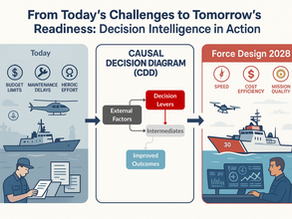top of page
Search
All Posts


Cutting Through the AI Noise: How Benchmarks Help You Find What Works
Benchmarks help cut through AI hype by showing each model’s strengths, weaknesses, and trade-offs. Our interactive dashboard makes these insights accessible for everyone—from business users to tech leaders—so you can explore accuracy, efficiency, cost, coding, or subject expertise in plain language. It’s not about declaring a single winner but about discovering which AI tool fits your needs and supports better decisions.
James 'Jim' Eselgroth
Sep 164 min read


Building Accessibility into the Digital Lifecycle with AI
AI is reshaping Section 508 accessibility from a compliance burden into a culture of accessibility. Automated tools accelerate checks, generative AI builds accessible content by default, and human oversight ensures quality. Leaders who adopt DevA11yOps—embedding accessibility into development, validation, and operations—can modernize digital services faster, fairer, and more effectively. Accessibility isn’t just compliance; it’s the foundation of digital modernization that se
Amen Tezera
Sep 114 min read


Which AI is Best for You? Our Summer Project Exploring LLMs
This summer, our newRoot Labs interns explored a big question: Which AI tool is best for you? Using Excel pairwise comparison formulas, Python web scraping, AWS storage, and Tableau dashboards, they built a system to compare LLMs across efficiency, accuracy, subject mastery, and reasoning ability. Their reflections on AI in school vs. the workplace reveal how learning with AI changes the way we build knowledge.
newRoot Labs
Sep 44 min read


Engineering with Empathy: Lessons from My Internship
During my internship at Red Cedar, I discovered that the true essence of software engineering goes beyond writing code—it’s about empathy, problem-solving, and carrying complexity so others don’t have to. From organizing proposals to merging LLM datasets with Python and learning DevOps practices, I gained technical skills and human-centered insights that will shape my career as a computer engineer.
James Cast
Sep 35 min read


Bridging Economics and Technology: My Internship Experience
This summer, I learned how economics and technology intersect in unexpected ways. As an intern in Red Cedar’s Technology and Innovation office, I applied classroom skills to real-world challenges, from building Excel formulas to writing my first Python code. Along the way, I discovered that economics isn’t just about markets—it’s about learning how to think, solve problems, and apply that mindset to data science and innovation.
Diya Gumaste
Sep 35 min read


Accelerating Outcomes: How Decision Intelligence Supports Force Design 2028
Discover how Decision Intelligence can turn the U.S. Coast Guard’s Force Design 2028 strategy into measurable action. Learn how connecting decisions to outcomes through the 5Ps framework—People, Policy, Process, Partners, and Platforms—can accelerate modernization, improve speed, reduce costs, and enhance mission quality. Practical insights, examples, and a readiness checklist included.
James 'Jim' Eselgroth
Aug 134 min read


Turning Coast Guard Strategy into Smart Action
The U.S. Coast Guard’s Force Design 2028 is an ambitious transformation plan, but its success depends on embedding continuous Decision Intelligence. Using Red Cedar’s OXYGEN framework—Organize, X-ray, Yield, Generate, Explain, Network—leaders can turn vision into sustained action, creating a living decision capability that adapts, scales, and delivers long-term mission advantage.
James 'Jim' Eselgroth
Aug 64 min read


Architecting the Modernization Roadmap: How Enterprise Architecture Accelerates Government and Industry Transformation
Enterprise Architecture (EA) is the foundation of successful modernization—aligning goals, capabilities, and technology into a mission-ready blueprint. In this article, we explore how EA turns siloed knowledge into structured insight, powering transformation across government and industry. Discover how Red Cedar’s ITX and OXYGEN frameworks embed architecture into every step of the modernization journey.
Ray Siguenza
Jul 315 min read


When the Waters Rose: How Technology, and Leadership, Could Have Changed the 2025 Flood Disasters in Texas & North Carolina
In July 2025, catastrophic floods devastated Texas and North Carolina, exposing critical failures in emergency response systems. This article explores how advanced technology—like AI-powered alerts, drones, and smart infrastructure—paired with strong leadership, could have saved lives and reduced chaos. Learn what went wrong, what could have helped, and what leaders must do to prepare for the next storm.
Audrey Walleser
Jul 234 min read
bottom of page
